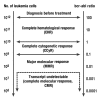Chronic myelogenous leukemia: treatment and monitoring
- PMID: 20221270
- PMCID: PMC2835925
- DOI: 10.3238/arztebl.2010.0114
Chronic myelogenous leukemia: treatment and monitoring
Abstract
Background: The treatment options for bcr-abl positive chronic myelogenous leukemia (CML) include chemotherapy, immune therapy, allogeneic stem cell transplantation, and molecular therapy. The tyrosine kinase inhibitor imatinib was approved for the treatment of CML in 2002. Data from clinical trials allow a comparison of treatment options.
Methods: The literature on the treatment and monitoring of CML was selectively reviewed. A total of 94 original articles were analyzed, along with the recommendations of an international expert committee and the medical societies. This review is current as of November 2009.
Results: In a clinical phase 3 trial of imatinib treatment for patients in the chronic phase of CML, the rates of progression-free and overall survival at 6 years were 93% and 88%, respectively. Thus, imatinib is clearly superior to interferon-alpha, hydroxyurea, and busulfan with respect to survival. Allogeneic stem-cell transplantation is only a fall back option because of transplantation-associated mortality. One in four patients in the chronic phase of CML has an inadequate cytogenetic response to imatinib and therefore requires a change of treatment. Most imatinib-resistant patients in the chronic phase of CML go into remission again after switching to one of the new tyrosine kinase inhibitors, dasatinib and nilotinib.
Conclusion: Imatinib is now the standard initial first-line treatment for CML in the chronic phase. Regular hematologic and cytogenetic monitoring during treatment is indispensable so that patients with an inadequate response can be identified.
Figures


Similar articles
-
Early allogeneic stem cell transplantation for chronic myelogenous leukemia in the imatinib era: a preliminary assessment.Blood Cells Mol Dis. 2006 Sep-Oct;37(2):116-24; discussion 125-7. doi: 10.1016/j.bcmd.2006.06.006. Epub 2006 Aug 10. Blood Cells Mol Dis. 2006. PMID: 16904348
-
Five-year follow-up of patients receiving imatinib for chronic myeloid leukemia.N Engl J Med. 2006 Dec 7;355(23):2408-17. doi: 10.1056/NEJMoa062867. N Engl J Med. 2006. PMID: 17151364 Clinical Trial.
-
Imatinib mesylate therapy improves survival in patients with newly diagnosed Philadelphia chromosome-positive chronic myelogenous leukemia in the chronic phase: comparison with historic data.Cancer. 2003 Dec 15;98(12):2636-42. doi: 10.1002/cncr.11831. Cancer. 2003. PMID: 14669283
-
[Imatinib therapy for patients with chronic myelogenous leukemia].Gan To Kagaku Ryoho. 2005 Mar;32(3):297-303. Gan To Kagaku Ryoho. 2005. PMID: 15791812 Review. Japanese.
-
Stem cell transplantation in patients with chronic myelogenous leukemia: when should it be used?Mayo Clin Proc. 2006 Mar;81(3):404-16. doi: 10.4065/81.3.404. Mayo Clin Proc. 2006. PMID: 16529146 Review.
Cited by
-
Recapitulating hepatitis E virus-host interactions and facilitating antiviral drug discovery in human liver-derived organoids.Sci Adv. 2022 Jan 21;8(3):eabj5908. doi: 10.1126/sciadv.abj5908. Epub 2022 Jan 19. Sci Adv. 2022. PMID: 35044825 Free PMC article.
-
Depressogenic effects of medications: a review.Dialogues Clin Neurosci. 2011;13(1):109-25. doi: 10.31887/DCNS.2011.13.1/ccelano. Dialogues Clin Neurosci. 2011. PMID: 21485751 Free PMC article. Review.
-
Molecular docking and pharmacophoric modelling of 1,5-disubstituted tetrazoles as inhibitors of two proteins present in cancer, the ABL and the mutated T315I kinase.In Silico Pharmacol. 2020 Nov 22;8(1):6. doi: 10.1007/s40203-020-00059-6. eCollection 2020. In Silico Pharmacol. 2020. PMID: 33240747 Free PMC article.
-
Effect of liver growth factor on both testicular regeneration and recovery of spermatogenesis in busulfan-treated mice.Reprod Biol Endocrinol. 2011 Feb 4;9:21. doi: 10.1186/1477-7827-9-21. Reprod Biol Endocrinol. 2011. PMID: 21294894 Free PMC article.
-
Inhibition of Aurora kinase B is important for biologic activity of the dual inhibitors of BCR-ABL and Aurora kinases R763/AS703569 and PHA-739358 in BCR-ABL transformed cells.PLoS One. 2014 Nov 26;9(11):e112318. doi: 10.1371/journal.pone.0112318. eCollection 2014. PLoS One. 2014. PMID: 25426931 Free PMC article.
References
-
- Baccarani M, Saglio G, Goldman J, et al. Evolving concepts in the management of chronic myeloid leukemia. Recommendations from an expert panel on behalf of the European Leukemia Net. Blood. 2006;108:1809–1820. - PubMed
-
- Hochhaus A, Brümmendorf T, Le Coutre P. Empfehlungen der DGHO für die Diagnostik und Therapie hämatologischer und onkologischer Erkrankungen. Chronische Myeloische Leukämie. http://www.dgho.de/onkopedia.
-
- National Comprehensive Cancer Network. NCCN Clinical Practice Guidelines in Oncology. Chronic Myelogenous Leukemia. www.nccn.org. - PubMed
-
- Hochhaus A, Druker B, Sawyers C, et al. Favorable long-term follow-up results over 6 years for response, survival, and safety with imatinib mesylate therapy in chronic-phase chronic myeloid leukemia after failure of interferon-alpha treatment. Blood. 2008;111:1039–1043. - PubMed
Publication types
MeSH terms
Substances
LinkOut - more resources
Full Text Sources
Medical
Miscellaneous

